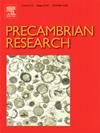坦桑尼亚克拉通东南缘Konse群——乌萨加兰造山带古元古代被动边缘演替:变质独居石年龄和大理岩同位素重碳约束
IF 3.2
2区 地球科学
Q2 GEOSCIENCES, MULTIDISCIPLINARY
引用次数: 0
摘要
康瑟群是一个2-3公里厚的石英岩、变质砾岩、云母片岩、大理岩、富锰变质沉积岩和基性变质火山序列,沉积在坦桑尼亚太古代克拉通东南缘的一个狭窄盆地中,长度超过200公里。古元古代乌萨加兰造山运动对盆地形成的时间有争议:它被解释为造山后覆覆褶皱的乌萨加兰片麻岩,或者是在克拉通边缘发育的前造山运动。在后一种情况下,Konse组被认为是一个较低品位的,时间相当于构造上覆的Usagaran片麻岩,它们代表了同一盆地的较深部分。富Mn3+的Konse群云母岩中氧化的近无u独居石的Th-Pb年龄为2028±15 Ma(95%置信度),与造山后沉积年龄相反。低U含量和Mn3+富集与前驱体沉积物的氧化条件有关。前乌萨加兰沉积时代由高正δ13C值(+12.6‰)和高正δ13C值(+9.3‰)支持,表明在约2.22-2.06 Ga Lomagundi事件期间沉积。这两个组的沉积时代和构造背景与其他东南部非洲克拉通的边缘序列相似,这些克拉通沉积于古元古代哥伦比亚/努纳超大陆组合的早期阶段。Konse和Mpwapwa组为克拉通被动边缘序列,属于乌萨加兰造山带。后者包含威尔逊旋回的基本岩性,表明现代板块构造在古元古代起作用。本文章由计算机程序翻译,如有差异,请以英文原文为准。
The Konse Group on the SE margin of the Tanzania Craton − a Paleoproterozoic passive margin succession of the Usagaran Orogen: Constraints from metamorphic monazite ages and isotopically heavy carbon in marbles
The Konse Group is a 2–3 km thick succession of quartzites, metaconglomerates, micaschists, marbles, Mn-rich metasediments and mafic metavolcanics deposited over >200 km in a narrow basin along the SE margin of the Archean Tanzania Craton. The timing of basin formation with respect to the Paleoproterozoic Usagaran orogeny is controversial: it is interpreted either as post-orogenic, overlying folded Usagaran gneisses, or as pre-orogenic, developed on the craton margin. In the latter case, the Konse Group is regarded as a lower-grade, time equivalent of the tectonically overlying Usagaran gneisses, which represent the deeper part of the same basin. Nearly U-free monazite from oxidized Mn3+-rich Konse Group micaschists yielded a Th-Pb age of 2028 ± 15 Ma (95 % confidence) for metamorphism, which argues against a post-orogenic depositional age. The low U content and Mn3+-enrichment are attributed to oxidizing conditions in the precursor sediment. The pre-Usagaran depositional age is supported by highly positive δ13C values, +12.6 and +9.3 ‰, for marbles of the Konse Group and correlative Mpwapwa Group to the northeast, respectively, indicating sedimentation during the ca. 2.22–2.06 Ga Lomagundi Event. Both groups share a similar depositional age and tectonic setting with marginal successions of other southeastern African cratons, which were deposited at early stages during the assembly of the Paleoproterozoic Columbia/Nuna supercontinent. The Konse and Mpwapwa groups represent cratonic passive margin successions, which belong to the Usagaran Orogen. The latter contains essential lithological members of a Wilson cycle, suggesting that modern-style plate tectonics operated during the Paleoproterozoic.
求助全文
通过发布文献求助,成功后即可免费获取论文全文。
去求助
来源期刊

Precambrian Research
地学-地球科学综合
CiteScore
7.20
自引率
28.90%
发文量
325
审稿时长
12 months
期刊介绍:
Precambrian Research publishes studies on all aspects of the early stages of the composition, structure and evolution of the Earth and its planetary neighbours. With a focus on process-oriented and comparative studies, it covers, but is not restricted to, subjects such as:
(1) Chemical, biological, biochemical and cosmochemical evolution; the origin of life; the evolution of the oceans and atmosphere; the early fossil record; palaeobiology;
(2) Geochronology and isotope and elemental geochemistry;
(3) Precambrian mineral deposits;
(4) Geophysical aspects of the early Earth and Precambrian terrains;
(5) Nature, formation and evolution of the Precambrian lithosphere and mantle including magmatic, depositional, metamorphic and tectonic processes.
In addition, the editors particularly welcome integrated process-oriented studies that involve a combination of the above fields and comparative studies that demonstrate the effect of Precambrian evolution on Phanerozoic earth system processes.
Regional and localised studies of Precambrian phenomena are considered appropriate only when the detail and quality allow illustration of a wider process, or when significant gaps in basic knowledge of a particular area can be filled.
 求助内容:
求助内容: 应助结果提醒方式:
应助结果提醒方式:


